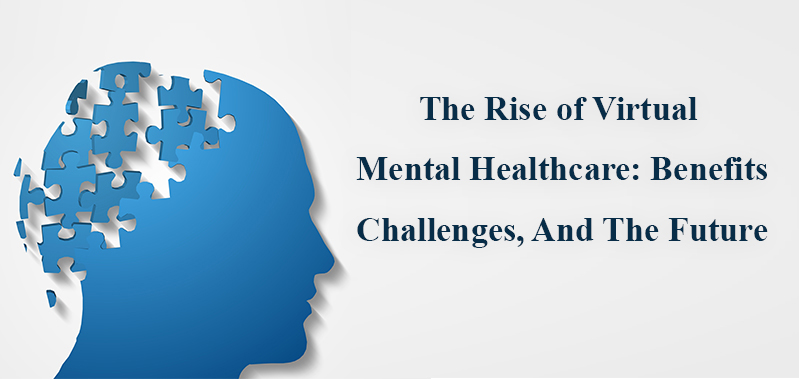
The Rise of Virtual Mental Healthcare: Benefits, Challenges, and the Future
The COVID-19 pandemic has highlighted the urgent need for behavioral health care services. A substantial portion of mental health care transitioned to virtual care during the COVID-19 pandemic remains virtual today and will continue that way in the future. Mental health needs continue to grow, and there has been increasing evidence showing the efficacy of virtual health for behavioral health conditions at the system, provider, and patient levels. There is also a growing understanding of the barriers and challenges to virtual behavioral health care.
Technological advancements
Significant technological advancements, such as high-speed internet, secure video conferencing tools, and enhanced data encryption technologies, have aided telemedicine's progress. These improvements have enabled the safe and efficient delivery of complicated and sensitive services, such as mental health treatment.
Benefits of digital interventions
A clear benefit of digital interventions (e.g., apps and chatbots) is that they can have an adjunctive use in therapy provision and are available 24/7, allowing clients to access support in between face-to-face therapy sessions and seek support in less sociable hours. However, a less-discussed benefit that is not emphasized enough is that some users may actually prefer to engage with the digital backing in the first instance and use 'digital' as a stepping stone for gaining confidence to step up onto traditional services (e.g., talking therapies). This preference could be due to the level of anonymity that digital support provides, allowing the client to avoid any stigma while mitigating the risk of feeling judged in a human-facing service17, as well as the agency to the individual offered by self-managed care. This idea is revisited later in this paper in the section related to digital ethics.
Another understated benefit is that the digital transformation of mental health provides future-proofing for the new generations of citizens who are more acquainted with digitally enhanced services. Mental health problems and disorders often develop during adolescence, and there must be early interventions (perhaps even digital interventions) to help mitigate against further escalation18. The younger generation has been coined 'generation mute' given that they are more likely to use smartphones to text rather than make phone calls, which could be aligned to the adoption and acceptance of typed therapy using chat-based CBT or chatbots. Younger generations may continue to expect most services to have a digital dimension and indeed be 'digital-first.' With this in mind, even the use of digital technologies that are less 'intervention' based can be the 'digital glue' that can enhance the quality of established services.
A less-discussed benefit is that a personalized collection of different digital interventions can be used together to help improve various aspects of an individual's mental well-being needs. It is important, given that mental well-being can be multifactorial and that different symptoms or even the same symptom can be addressed by a collection of diverse digital tools that are all available 24/7. This is what is called 'poly-digital' (Fig. 3), which is the idea that different digital tools can be prescribed based on an individual's needs (i.e., personalized healthcare). For example, a sleep app can be used to improve sleep hygiene while simultaneously using a mindfulness app and a mood logging app to enhance a positive mindset.
Digital technologies can facilitate the collection of high-quality data and repeated measures (both digital phenotyping and EMA) from clients outside of therapy, better informing the service provider and improving the quality of the time spent with the client face-to-face.
Challenges and Solutions
While telemedicine in mental health offers numerous benefits, it also presents challenges that need to be addressed to ensure its widespread adoption and effectiveness.
1. Technology Access and Literacy: Not all patients have access to the necessary technology or the skills to use it effectively. Solutions include providing educational resources, offering technical support, and ensuring that telemedicine platforms are user-friendly and accessible on multiple devices.
2. Regulatory and Reimbursement Issues: Telemedicine regulations and reimbursement policies vary by region and are often complex. Efforts to standardize rules and ensure fair reimbursement for telemedicine services are essential for its sustainable growth.
3. Privacy and Security: Ensuring the confidentiality and security of patient information is crucial. Telemedicine platforms must comply with healthcare privacy regulations, such as HIPAA in the United States and implement robust security measures to protect patient data.
4. Quality of Care: There is a concern that virtual consultations may not offer the same level of care as in-person visits. Healthcare providers need to be trained in telemedicine best practices, and telemedicine should be integrated with traditional care to ensure comprehensive patient management.
Future directions
In conclusion, AI's dynamic potential in behavioral health promises a transformative path forward. With personalized interventions, global accessibility, and proactive support, AI stands as a beacon for a future where technology and empathy synergize to nurture mental wellness through the use of AI for mental health.
The fusion of AI with emergent technologies like Virtual Reality (VR) and portable devices augments this trajectory. VR's immersive experiences enable exposure therapy, while AI-integrated portable devices empower proactive self-care. This fusion of technologies exemplifies a holistic and impactful approach to mental health care, emphasizing the pivotal role of AI in enriching the pursuit of well-being.




